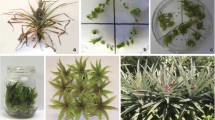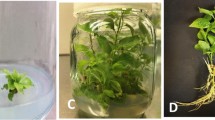Abstract
Vegetative propagation of plants, such as garlic (Allium sativum L.), is known to facilitate the transmission of several virus species throughout the plant cycles. This process favors the onset of complex diseases by accumulation of different species in the same plant, resulting in decreased productivity and production quality. Studies have reported the use of cryotherapy of shoot tips, or meristematic clusters, as an efficient tool for obtaining virus-free plants. This study aimed to evaluate the ability of cryotherapy to eradicate virus complex in garlic plants. Bulbils naturally infected with Onion Yellow Dwarf Virus (OYDV), Leek Yellow Strip Virus (LYSV) and Garlic Common Latent Virus (GCLV) were employed as explants for different virus-cleaning treatments tested. Dot-ELISA and RT-PCR analysis were used to demonstrate the presence/absence of virus complex, and histological analysis was also performed to confirm these results. Five days after cryotherapy, structural analysis revealed that cooling had caused cell damage, as indicated by the increased vacuolization of cells after cryotherapy, as well as slight plasmolysis after thermotherapy. Immunolocalization analysis indicated the subcellular distribution of OYDV in garlic shoot tips in association with the development of plasmodesmata, while no OYDV was detected in the first cell layers of the meristematic dome. Cryotherapy successfully removed virus complex, resulting in virus-free plants with enhanced efficiency, compared to conventional meristem culture-based techniques. Moreover, the synergistic effects of cryotherapy and thermotherapy resulted in a 40 % survival rate of shoot tips and the regeneration of 90, 100 and 80 % OYDV-, LYSV- and GCLV-free plants, respectively.





Similar content being viewed by others
References
Ayabe M, Sumi S (2001) A novel and efficient tissue culture method—“stem-disc dome culture”—for producing virus-free garlic (Allium sativum L.). Plant Cell Rep 20:503–507
Baek H, Kim H, Cho E, Chae Y, Engelmann F (2003) Importance of explant size and origin and of preconditioning treatments for cryopreservation of garlic shoot apices by vitrification. Cryo-Letters 24:381–388
Brison M, Boucaud M-T, Pierronnet A, Dosba F (1997) Effect of cryopreservation on the sanitary state of a cv. Prunus rootstock experimentally contaminated with Plum Pox Potyvirus. Plant Sci 123:189–196
Chellappan P, Vanitharani R, Ogbe F, Fauquet CM (2005) Effect of temperature on geminivirus-induced RNA silencing in plants. Plant Physiol 138:1828–1841
Cooper VC, Walkey DGA (1978) Thermal inactivation of cherry leaf roll virus in tissue cultures of Nicotiana rustica raised from seeds and meristem-tips. Ann Appl Biol 88:273–278
Crowe JH, Oliver AE, Hoekstra FA, Crowe LM (1997) Stabilization of dry membranes by mixtures of hydroxyethyl starch and glucose: the role of vitrification. Cryobiol 35:20–30
Dello Ioio R, Linhares FS, Sabatini S (2008) Emerging role of cytokinin as a regulator of cellular differentiation. Curr Opinion Plant Biol 11:23–27
Ellis D, Skogerboe D, Andre C, Hellier B, Volk GM (2006) Implementation of garlic cryopreservation techniques in the national plant germplasm system. Cryo-Letters 27:99–106
Engelmann F (2004) Plant cryopreservation: progress and prospects. In Vitro Cell Dev Biol Plant 40:427–433
Faccioli G, Marani F (1998) Virus elimination by meristem tip culture and tip micrografting. In: Hadidi A, Khetarpal RF, Koganezawa H (eds) Plant virus diseases control. APS Press, St Paul, pp 346–380
Fajardo TVM, Nishijima M, Buso JA, Torres AC, Ávila AC, Resende RO (2001) Garlic viral complex: identification of Potyviruses and Carlavirus in central Brazil. Fitopatol Bras 26:619–626
Foster TM, Lough TJ, Emerson SJ, Lee RH, Bowmann JL, Forster RLS, Lucas WJ (2002) A surveillance system regulates selective entry of RNA into the shoot apex. Plant Cell 14:1497–1508
Ghaemizadeh F, Dashti F, Khodakaramian G, Sarikhani H (2014) Combination of stem-disc dome culture and thermotherapy to eliminate Allexiviruses and Onion yellow dwarf virus from garlic (Allium sativum cv. Hamedan). Arch Phytopathol Plant Protect 47:499–507
Helliot B, Panis B, Poumay Y, Swenen R, Lepoivre P, Frison F (2002a) Cryopreservation for the elimination of cucumber mosaic and banana streak viruses from banana (Musa spp.). Plant Cell Rep 20:1117–1122
Helliot B, Madur D, Dirlewanger E, De Boucaud MT (2002b) Evaluation of genetic stability in cryopreserved Prunus. In Vitro Cell Dev Biol Plant 38:493–500
Helliot B, Swennen R, Poumay Y, Frison E, Lepoivre P, Panis B (2003) Ultrastructural changes associated with cryopreservation of banana (Musa spp.) highly proliferating meristems. Plant Cell Rep 21:690–698
Hills BP, Nott KP (1999) Studies of water compartmentation in carrot parenchyma tissue during drying and freezing. Appl Magn Reson 17:521–535
Keller ERJ (2005) Improvement of cryopreservation results in garlic using low temperature preculture and high-quality in vitro plantlets. Cryo-Letters 26:357–366
Keller ERJ, Senula A (2013) Micropropagation and cryopreservation of garlic (Allium sativum L.). Meth Mol Biol 11013:353–368
Kim H, Cho E, Baek H, Kim C, Keller ERJ, Engelmann F (2004) Cryopreservation of garlic shoot tips by vitrification: effects of dehydration, rewarming, unloading and regrowth conditions. Cryo-Letters 25:59–70
Kim H, Lee J, Yoon J, Ji J, Nam S, Hwang H, Cho E, Engelmann F (2006) Cryopreservation of garlic bulbil primordia by the droplet-vitrification procedure. Cryo-Letters 27:143–153
Kim H, Lee J, Hwang H, Engelmann F (2007) Cryopreservation of garlic germplasm collections using the droplet-vitrification technique. Cryo-Letters 28:471–482
Kobayashi K, Zambryski P (2007) RNA silencing and its cell-to-cell spread during Arabidopsis embryogenesis. Plant J 50:597–604
Lartey RT, Ghoshroy S, Citovsky V (1998) Identification of an Arabidopsis thaliana mutation (vsm1) that restricts systemic movement of tobamoviruses. Mol Plant Microbe Interact 11:706–709
Leisova-Svobodova L, Karlova-Smekalova K (2011) Detection of garlic viruses using SYBR green real-time reverse transcription-polymerase chain reaction. J Phytopathol 159:429–434
Lucas WJ (2006) Plant viral movement proteins: agents for cell-to-cell trafficking of viral genomes. Virology 344:169–184
Melo-Filho PA, Resende RO, Cordeiro CMT, Buso JA, Torres AC, Dusi NA (2006) Viral reinfection affecting bulb production in garlic after seven years of cultivation under field conditions. Eur J Plant Pathol 116:95–101
Mochizuki T, Ohki ST (2004) Shoot meristem tissue of tobacco inoculated with Cucumber mosaic virus is infected with the virus and subsequently recovers from infection by RNA silencing. J Gen Plant Pathol 70:363–366
Morel GM, Wetmore RH (1951) Tissue culture of monocotyledons. Am J Bot 38:138–140
Murashige T, Skoog F (1962) A revised medium for rapid growth and biossays with tobacco tissue cultures. Physiol Plant 15:473–497
Niwata E (1995) Cryopreservation of Allium. Cryo-Letters 16:102–107
Oparka KJ, Roberts AG, Boevink P, Cruz SS, Roberts I, Pradel KS, Imlau A, Kotlizky G, Sauer N, Epe B (1999) Simple, but not branched, plasmodesmata allow the nonspecific trafficking of proteins in developing tobacco leaves. Cell 97:743–754
Parrano L, Afunian M, Pagliaccia D, Douhan G, Vidalakis G (2012) Characterization of viruses associated with garlic plants propagated from different reproductive tissues from Italy and other geographic regions. Phytopathol Mediterr 51:549–565
Qu F, Ye XH, Hou GC, Sato S, Clemente TE, Morris TJ (2005) RDR6 has a broad-spectrum but temperature-dependent antiviral defense role in Nicotiana benthamiana. J Virol 79:15209–15217
Rodrigues JCM, Souza ML, O’Reilly D, Velloso LM, Pinedo FJR, Razuck FB, Ribeiro B, Ribeiro BM (2001) Characterization of the ecdysteroid UDP-Glucosyltransferase (egt) gene of Anticarsia gemmatalis nucleopolyhedrovirus. Virus Genes 22:103–112
Sakai A, Kobayashi S, Oiyama I (1990) Cryopreservation of nucellar cells of navel orange (Citrus sinensis Osb. var. Brasiliensis tanaka) by vitrification. Plant Cell Rep 9:30–33
Schwach F, Vaistij FE, Jones L, Baulcombe DC (2005) An RNA-dependent RNA polymerase prevents meristem invasion by potato virus X and is required for the activity but not the production of a systemic silencing signal. Plant Physiol 138:1842–1852
Stott DI (1989) Immunoblotting and dot blotting. J Immunol Methods 119:153–187
Szittya G, Silhavy D, Molnar A, Havelda Z, Lovas A, Lakatos L, Banfalvi Z, Burgyan J (2003) Low temperature inhibits RNA silencing-mediated defence by the control of siRNA generation. EMBO J 22:633–640
Volk GM, Maness N, Rotindo K (2004) Cryopreservation of garlic (Allium sativum L.) using plant vitrification solution 2. Cryo-Letters 25:219–226
Wang Q, Valkonen JPT (2008) Efficient elimination of sweetpotato little leaf phytoplasma from sweetpotato by cryotherapy of shoot tips. Plant Pathol 57:338–347
Wang Q, Valkonen JPT (2009) Cryotherapy of shoot tips: novel pathogen eradication method. Trends Plant Sci 14:119–122
Wang Q, Munir M, Li P, Gafny R, Sela I, Tanne E (2003) Elimination of grapevine virus A (GVA) by cryopreservation of in vitro-grown shoot tips of Vitis vinifera L. Plant Sci 165:321–327
Wang Q, Cuellar WJ, Rajamäki M, Hirata Y, Valkonen JPT (2008) Combined thermotherapy and cryotherapy for efficient virus eradication: relation of virus distribution, subcellular changes, cell survival and viral RNA degradation in shoot tips. Mol Plant Pathol 9:237–250
Wang Q, Panis B, Engelmann F, Lambardi M, Valkonen JPT (2009) Cryotherapy of shoot tips: a technique for pathogen eradication to produce healthy planting materials and prepare healthy plant genetic resources for cryopreservation. Ann Appl Biol 154:351–363
Wen GY, Mato A, Wisniewski HM, Malik MN, Jenkins EC, Sheikh AM, Kim KS (2005) Light and electron microscopic immunocytochemical localization of two major proteins in garlic bulb. J Cell Biochem 58:481–489
Acknowledgments
The authors thank Empresa Brasileira de Pesquisa Agropecuária (EMBRAPA) for financial support of this research.
Author information
Authors and Affiliations
Corresponding author
Additional information
Communicated by M. Capuana.
Rights and permissions
About this article
Cite this article
Vieira, R.L., da Silva, A.L., Zaffari, G.R. et al. Efficient elimination of virus complex from garlic (Allium sativum L.) by cryotherapy of shoot tips. Acta Physiol Plant 37, 1733 (2015). https://doi.org/10.1007/s11738-014-1733-3
Received:
Revised:
Accepted:
Published:
DOI: https://doi.org/10.1007/s11738-014-1733-3




